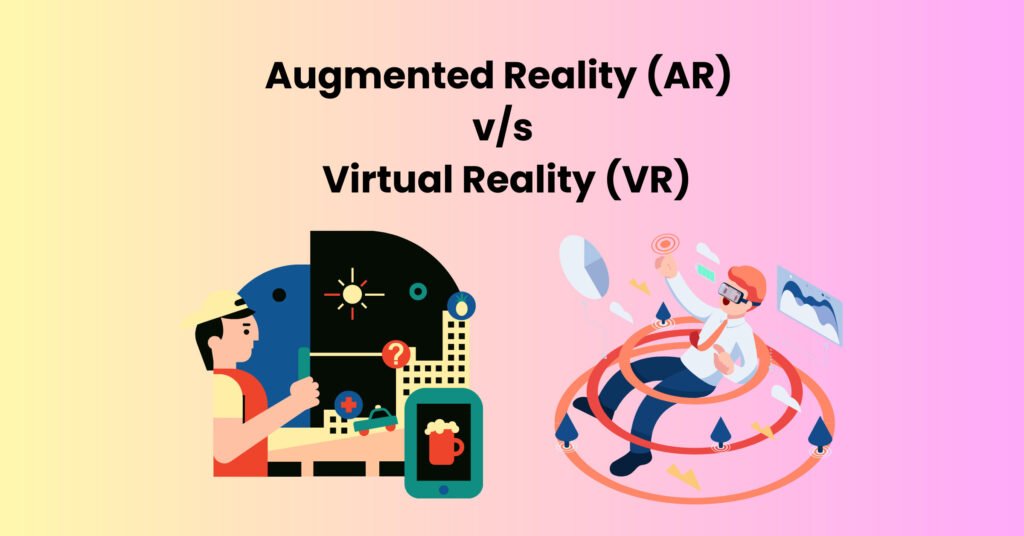
The evolution of technology continues to bridge the gap between the real and the virtual, and two terms that often pop up in this context are Augmented Reality (AR) and Virtual Reality (VR). Both technologies offer immersive experiences, but in distinct ways. This blog dives deep into AR and VR, uncovering what they are, how they differ, and the transformative potential they hold for various sectors.
What is Virtual Reality (VR)?
Virtual Reality immerses users in a fully artificial digital environment. With a VR headset on, you are taken to a different world altogether, whether it’s the surface of Mars, the depths of the ocean, or a fictional realm.
The Essence of Virtual Reality
At its core, Virtual Reality (VR) is an experience. It’s a journey into realms that may not exist, a walk on the wild side of our imagination, and an immersion into reconstructions of reality. When we don the VR headset, what we’re doing is essentially replacing our natural perception of the world with a digital recreation. The room you’re sitting in fades away, and suddenly you’re atop a mountain, beneath the sea, or in a distant galaxy.
How Does VR Work?
- Visual Immersion: The primary sense targeted by VR is vision. High-definition screens inside the VR headset positioned close to the eyes create a stereoscopic effect. This gives depth to the digital world, allowing us to perceive things in three dimensions, just like in real life.
- Audio Depth: Quality VR experiences often come equipped with spatial audio, which changes as you move your head. If there’s a waterfall to your right in the VR world, you’ll hear it on the right. If you turn toward it, the sound smoothly shifts, giving the illusion of being surrounded by the environment.
- Motion and Interaction: Modern VR systems often come equipped with motion sensors and handheld controllers. These track your movements. If you crouch, your VR avatar crouches. If you reach out to pick something up, your virtual hand mirrors your movement.
- Real-world Applications of VR:
- Education and Training: Using VR, astronauts can experience the harshness of space without leaving Earth, while medical students can ‘perform surgery’ before they ever touch a patient.
- Gaming: This is perhaps the most well-known application. Games like “Half-Life: Alyx” or “Beat Saber” offer fully immersive worlds that players can interact with.
- Therapy and Rehabilitation: Exposure therapy in VR can help treat phobias. Patients can confront and deal with their fears in a controlled, digital setting.
- Architectural Visualization: Before the first brick is laid, architects and clients can walk through a building, experiencing space and design in full scale.
Beyond the technical marvels, VR poses intriguing questions about the nature of reality. If our senses can be fully tricked into believing that a digital world is “real,” what does that say about our perception of the real world? Films like “The Matrix” and thought experiments in philosophy have explored these ideas deeply.
Virtual Reality is more than just a technology; it’s a doorway. A doorway to new worlds, experiences, and understandings. As the technology matures, we’re not just looking at better graphics or smoother interactions; we’re looking at redefining the very essence of experience and perception. As VR continues to grow, we must also grapple with its implications, ensuring we harness its potential for the betterment of society.
Key Features of VR:
- Complete Immersion: It transports users to a different environment.
- Interactivity: Most VR platforms allow users to interact with their virtual surroundings using handheld controllers or motion sensors.
- Isolation: It’s mostly an isolated experience since users are cut off from the real world.
What is Augmented Reality (AR)?
Augmented Reality overlays digital content in the real-world environment. Think of the mobile game Pokémon GO where players catch virtual creatures in their real surroundings or the Snapchat filters that add digital elements to our faces.
Augmented Reality (AR) has emerged as a groundbreaking technology that seamlessly intertwines the digital and the physical, offering users an enhanced and interactive experience of the world around them. While the term might sound complex, many of us have already encountered it in playful and practical applications, like the globally popular game Pokémon GO or the quirky Snapchat filters. Let’s delve deeper into this fascinating technology.
At its core, AR superimposes computer-generated images, sounds, or other data onto our view of the real world. Unlike Virtual Reality (VR), which immerses users in a completely digital environment, AR enhances the existing environment with additional layers of digital content.
The potential for AR is immense, stretching beyond games and filters. Industries ranging from healthcare to real estate to entertainment are exploring its capabilities. As technology continues to advance, the lines between the digital realm and our tangible world will blur further, making AR experiences even more immersive and integrated into our daily lives.
Augmented Reality is more than just a technological marvel; it’s an evolving tool that enhances our interaction with the world. By overlaying digital content on real-world environments, AR provides enriched experiences, blending the boundaries of what’s virtual and what’s real. As it continues to weave into various sectors, AR promises a future where digital augmentation becomes a natural extension of our perceptions.
Key Features of AR:
- Partial Immersion: AR adds to the real world; it doesn’t replace it.
- Real-time Interaction: Users interact with both digital elements and the real world simultaneously.
- Accessibility: Many AR applications can run on smartphones and tablets without the need for specialized equipment.
AR vs. VR: Major Differences
- Nature of Experience: VR offers a complete escape from reality, whereas AR enhances the real world with digital components.
- Hardware Requirements: While VR often requires dedicated headsets (e.g., Oculus Rift, HTC Vive), AR can usually be accessed with smartphones and AR glasses like Google Glass.
- Applications: VR is popular in gaming, training simulations, and virtual tourism. In contrast, AR shines in areas like retail (virtual try-ons), maintenance (overlaying instructions), and navigation (direction overlays).
The Potential Impact of AR and VR
Education: Imagine history lessons where students can virtually walk through ancient civilizations or biology classes where they can explore the human body from the inside. Both AR and VR can revolutionize learning by making it more engaging and interactive.
Healthcare: Surgeons can practice complicated procedures in a virtual environment before performing actual surgeries. AR can assist in real-time during surgeries by overlaying helpful data.
Real Estate: Instead of physical visits, potential buyers can take virtual tours of properties. With AR, they can also visualize how furniture and decorations will look in a particular space.
Entertainment: The gaming and entertainment industries are already harnessing the power of AR and VR for more immersive experiences, from interactive games to virtual concerts.
Future Predictions
The boundaries between AR and VR are expected to blur with the advent of Mixed Reality (MR), which combines the best of both worlds. As technology continues to advance, we can anticipate more accessible, affordable, and versatile AR and VR solutions that seamlessly integrate into our daily lives.
The world is at the cusp of a digital transformation, with AR and VR leading the charge. While both offer different experiences, their collective aim is to enrich our lives, making the impossible possible. As we continue to innovate, it’s clear that the line between our reality and the digital realm will become increasingly blurred, opening doors to endless possibilities.




